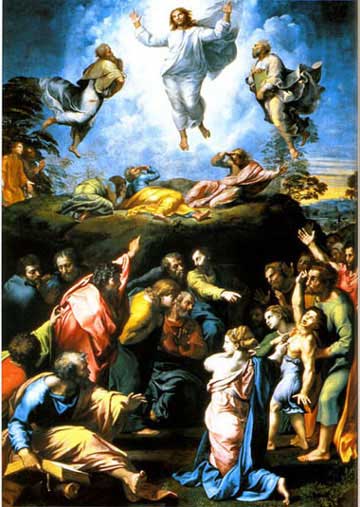
Home


 

 Details from Rafael's Transfiguration 30 L: Moses Holding Tablets 40 L: Transfigured Christ 50 L: Prophet Elijah with Book 100 L: Apostles John and Peter 150 L: Group of Women 200 L: Landscape Scott 595-600 (1976) August 6 on the Catholic Liturgical calendar marks the celebration of the Feast of the Transfiguration. In 1976, Vatican City issued a set of six stamps showing details from Raphael's remarkable painting of the Transfiguration, a work completed in 1520. This was the last of the great Renaissance artist's works, as he died later that year. The painting was originally conceived as an altarpiece for Narbonne Cathedral in France but is now housed in the Pinacoteca of the Vatican Museum. In addition to the stamps from 1976, the work was the highlight of the souvenir sheet released in 2020 to mark the fifth centenary of the death of Raphael:  
 5th Centenary of the Death of Raphael Top: Souvenir Sheet (Scott 1744) Bottom: Detail and Raphael Self-portrait (Scott 1744a & 1744b), 2020 As depicted in Raphael's work, the Transfiguration is one of the most visually stunning accounts in the Bible. The story is presented fairly consistently in the three Synoptic Gospels (Mark 9:2-8, Luke 9:28-36 and Matthew 17:1-9). Here is the account from Matthew 17: Jesus took Peter, James, and John his brother, and led them up a high mountain by themselves. And he was transfigured before them; his face shone like the sun and his clothes became white as light. And behold, Moses and Elijah appeared to them, conversing with him. Then Peter said to Jesus in reply, “Lord, it is good that we are here. If you wish, I will make three tents here, one for you, one for Moses, and one for Elijah.” While he was still speaking, behold, a bright cloud cast a shadow over them, then from the cloud came a voice that said, “This is my beloved Son, with whom I am well pleased; listen to him.” When the disciples heard this, they fell prostrate and were very much afraid. But Jesus came and touched them, saying, “Rise, and do not be afraid.” And when the disciples raised their eyes, they saw no one else but Jesus alone.With this, the apostles have been given a small hint of the power and majesty of God and the glory of Heaven. Shown below is the painting by Raphael as it appears in the Vatican Museum. The work actually portrays two events which appear consecutively in the Gospel according to Matthew. The top section depicts the Transfiguration, with the transfigured Christ between the prophets Moses and Elijah (Matthew 17: 1-9). The lower panel shows the meeting of the Apostles with the "Obsessed Boy", who Christ miraculously cures upon his return from Mount Tabor (Matthew 17: 14-20).  Rafael's Transfiguration Pinacoteca of the Vatican Museum Wikimedia Commons (in the public domain) REFERENCES: |